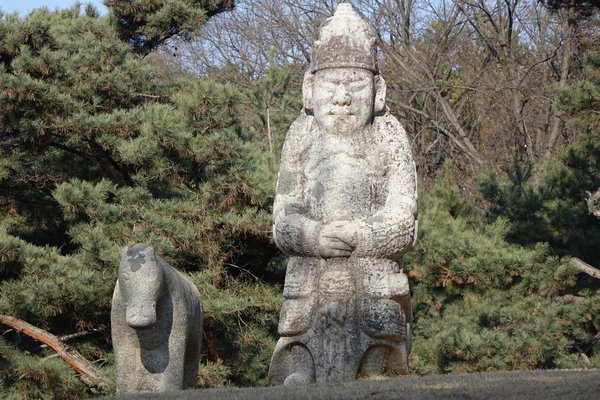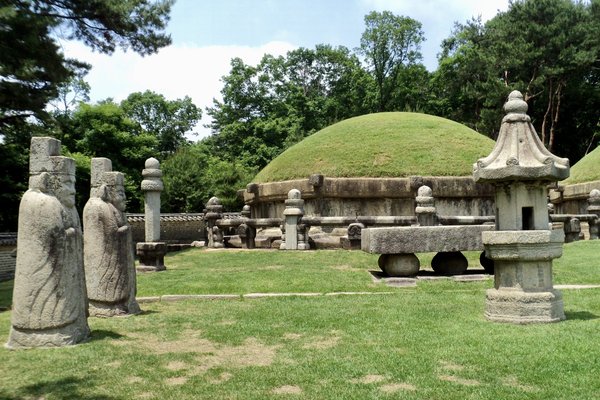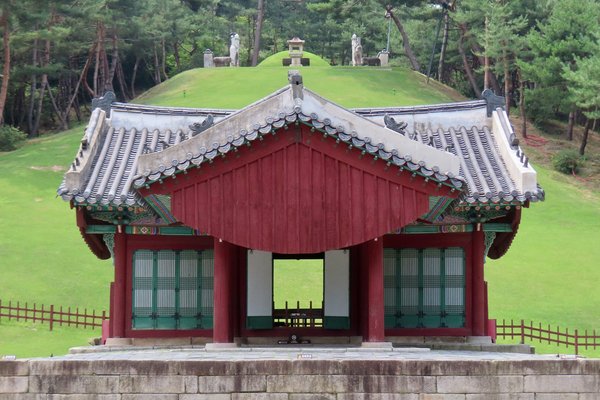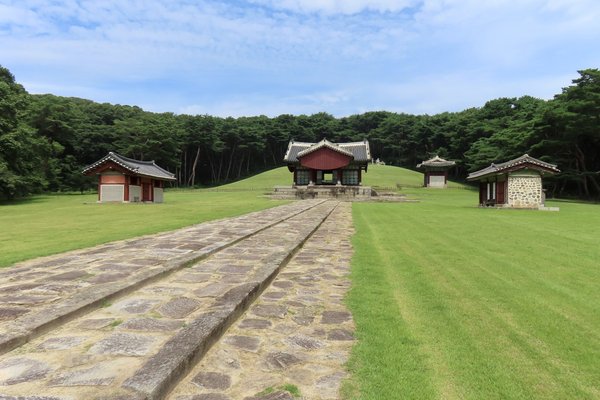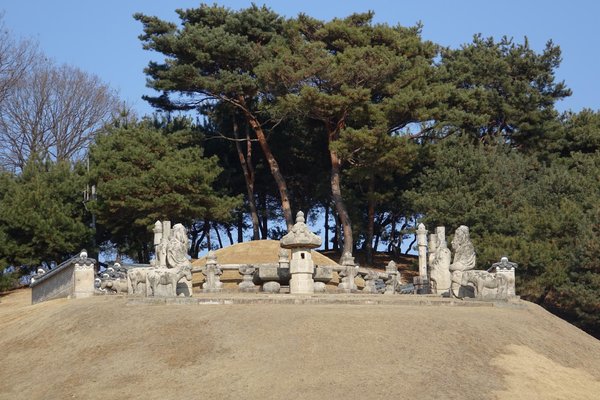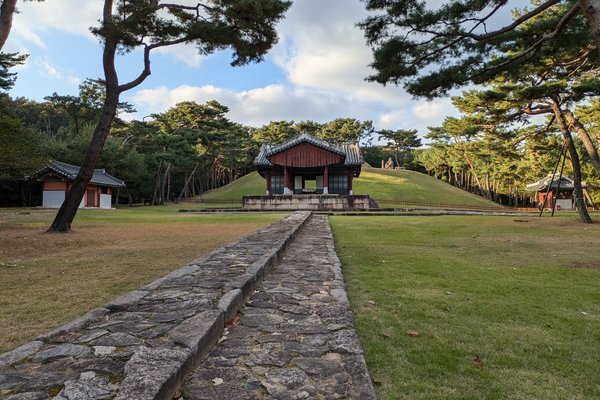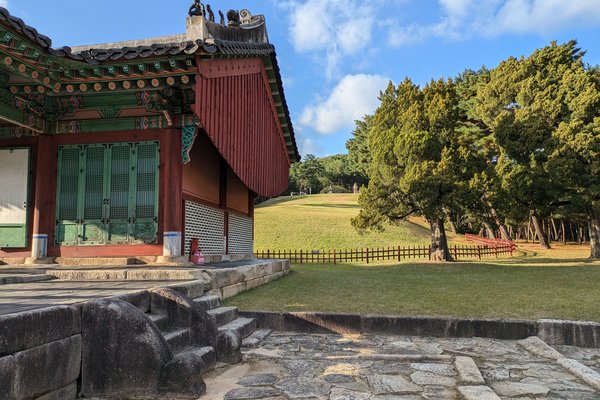Republic of Korea
Royal Joseon Tombs
The Royal Tombs of the Joseon Dynasty were built at scenic locations to honor the dynastic ancestors.
The tombs dating from the period 1408-1966 were used for Joseon Dynasty kings and their consorts. They lie in a setting shaped by the geomantic principles of pungsu and are part of a living tradition of ancestral worship. The tombs are all burial mounds with associated buildings such as wooden shrines, the royal kitchen and the guard's house.
Community Perspective: Dongguerung is an easy and lovely site to visit from Seoul and is ranked first by Kyle who has visited 13 out of the 18 inscribed clusters of tombs. The cluster near Seoul's Seollung subway station is an even easier ‘tick’.
Site Info
Official Information
- Full Name
- Royal Tombs of the Joseon Dynasty (ID: 1319)
- Country
- Republic of Korea
- Status
-
Inscribed 2009
Site history
History of Royal Joseon Tombs
- 2009: Inscribed
- Inscribed
- Type
- Cultural
- Criteria
- iii
- iv
- vi
Links
- UNESCO
- whc.unesco.org
- Official
-
- english.visitkorea.or.kr — Visit Korea Royal Tombs of the Joseon Dynasty
- english.cha.go.kr — Cultural Heritage Administration Royal Tombs
All Links
UNESCO.org
- whc.unesco.org — whc.unesco.org/
Official Website
- english.visitkorea.or.kr — Visit Korea Royal Tombs of the Joseon Dynasty
- english.cha.go.kr — Cultural Heritage Administration Royal Tombs
News Article
- Sept. 30, 2025 koreaherald.com — Nine autumn forest trails at the Royal Tombs of the Joseon Dynasty will open to the public
- March 30, 2015 koreajoongangdaily.joins.com — Jeongneung Shrine complex is restored to former glory
- Oct. 4, 2009 koreatimes.co.kr — 490 Billion Won to Restore Royal Tombs of Joseon
- June 28, 2009 koreatimes.co.kr — Joseon Royal Tombs Emerge as World Heritage
Community Information
- Community Category
- Secular structure: Burial
Travel Information
One million visitors or more
WHS Commandments Stars
Meets all 10 criteria, plus all 18 clusters have an individualized paper ticket including …
Seoul hotspot
Recent Connections
-
WHS Commandments Stars
Meets all 10 criteria, plus all 18 clus…
-
Perfect Inscriptions
2009 -
Notable Trees
* Korean Box Tree of Yeongneung Royal T…
Connections of Royal Joseon Tombs
- Individual People
-
-
Toyotomi Hideyoshi
"The Seolleung unusually had a lot of mishaps and suffered an indignity. During the Imjinwaeran, (the Japanese invasion of Korea in 1592), the royal tomb was dug up and the Jaegung (a house built next to the tomb for sacrificial rites) was burned." - Cultural Heritage Administration of Korea (CHA) "In continuation of the diplomatic talks toward peaceful relations, Korea in 1606 demanded that the Shogun write a formal letter requesting peace, and that the Japanese soldiers who had defiled the royal tombs (Seolleung) in Seoul be extradited." - wiki -
Isabella Bird
Visited 1894, the royal tomb of a princess is described in detail with a sketch of a tomb guardian. (published in Korea and her Neighbours, a narrative of travel, with an account of the vicissitudes and position of the country Volume 1) pg. 63. -
Homer B. Hulbert
Royal Tombs of the Joseon Dynasty - "In the case of very wealthy men or of princes, the grave site will be ornamented with stone figures of men and animals, arranged on either side and facing each other." - The Passing of Korea (1905) Pg 455
-
- Geography
-
-
Located in a Capital City
Seoul (Capital of South Korea)
-
- Trivia
-
-
One million visitors or more
Around 2.36 million visitors went to see the Royal Tombs of the Joseon Dynasty in South Korea in 2023 // "More than 1.02 million people visited royal tombs of the Joseon scattered around Seoul and the nearby Gyeonggi Province during the same period." -
Moved from location of original construction
It was not uncommon for queen, royal concubine, or crown prince tombs to be moved following the death of a king or in some cases political manuevering. Tombs have also been moved following a re-evaluation of the importance of the royal person. Jeongneung - "After the death of King Taejo, the tomb of Queen Sindeok was moved to Yangju, Saeulhallok, the current place of the Jeongneung." - Cultural Heritage Administration of Korea (CHA) -
WHS within walking distance
Seoul
-
- History
-
-
Contains significant structures from the 20th Century
"Hongneung of Emperor Gojong" (1852-1919, Reigned 1863-1907) - Tomb 34 and "Yureung of Emperor Sunjong" (1874-1926, Reigned 1907-1910, Nom file states tomb constructed 1923) - Tomb 35 -
Joseon Dynasty
-
- Ecology
-
-
Notable Trees
* Korean Box Tree of Yeongneung Royal Tomb, Yeoju (National Monument) The box tree is an evergreen with thick, oval-shaped leaves, flowers that bloom from April to May, and brown fruit that ripens from June to July. ..this box tree not only has great biological importance but is also an interesting historical item, having stood in the Tomb Keeper's House at Yeongneung Royal Tomb, Yeoju, which was built in 1673, for more than 300 years" * Korean Plum-yem of Yungneung Royal Tomb, Hwaseong (National Monument) "While the Korean plum-yem seldom surpasses 3m in height, this one at the Yungneung Royal Tomb stands 4m tall, measuring 80cm in girth, making it the tallest as well as the largest tree of its kind in Korea. The tree appears to have been planted at the time of the construction of the shrine at this grave yard.
-
- Architecture
-
-
Geomancy
"The Joseon Royal Tombs reflect how pungsu (fengshui in Chinese), the principle of geomancy, was applied in their site selection. As a result, the Royal Tombs are discreetly scattered around the capital area." - Nomination File -
Wooden architecture
All Joseon tombs contain a T-shaped shrine. "The T-shaped shrine reflected traditional Korean wooden architecture and was built with round wooden pillars erected on neatly dressed cornerstones. The wooden beams were buttressed with simple wing-like brackets." - nomination file
-
- World Heritage Process
-
-
Perfect Inscriptions
2009
-
- Religion and Belief
-
-
Sacred Forests or Groves
Gwangneung Forest was considered sacred during the Joseon Dynasty. The forest was protected and served as an ideal location for Gwangneung, a royal tomb constructed under Confucian principles. -
Confucianism
Within the context of Confucian cultures, the integrated approach of the Royal Tombs of Joseon to nature and the universe has resulted in a distinctive and significant funeral tradition. -
Legends and Folk Myths
"The 22nd king, Jeongjo (r. 1776-1800), during a visit to his father's tomb (Yungneung), found the pine grove around the graveyard withering because of pine-eating caterpillars. In lamentation, the king caught one and bit it to death. Strangely, the caterpillars completely disappeared soon afterward." - nomination file -
Taoism
"Taoism strongly affected the selection or arrangement of the stone animals. The cross arrangement of the stone sheep and of the stone tigers seems to reflect the concept of yin and yang. Taegeuk, the symbol of the Supreme Ultimate, is found in the middle part of the Buddhist yeongtak (bell) design; the 12 zodiac gods with elements inspired by Buddhism appear on the stone retaining walls; and there are repeated cloudpatterns. All of these are manifestations of Taoist symbolism." - nomination file -
Ancestor Worship
Criteria iv: ".. The royal tombs, in their response to settings and in their unique (and regularized) configuration of buildings, structures and related elements, manifest and reinforce the centuries old tradition and living practice of ancestral worship through a prescribed series of rituals." (OUV)
-
- Human Activity
-
-
Festivals
Danjong Culture FestivalSee www.mct.go.kr
-
Irrigation and drainage
"Ponds built at the Joseon royal burial grounds are mostly square, with round miniature islands, and serve to reinforce favorable energy at the entrance to the burial grounds while also aiding management of drainage of the royal tombs and supporting the caretakers' activities." - nomination file
-
- Constructions
-
-
Dynastic Burial Places
-
Stelae
All Joseon Dynasty Tombs contain this type of stelae. - Bigak, a building which has a stone monument where the names of the king and the queen are written at the front, while at the back was written the list of the king's accomplishments. -
Pillars
All Joseon Dynasty Tombs contain these types of pillars - Mangjuseokm, this is a pair of stone pillars erected on both sides of the mound. - Hongsalmun, this is the gate with two red cylindrical pillars. -wiki -
Bixi
Numerous Bigak buildings contain Bixi stone tablets. "Bigak - A building which has a stone monument where the names of the king and the queen are written at the front, while at the back was written the list of the king's accomplishments." wiki (Bixi diagrams are illustrated in the Joseon Royal Tombs Nomination File)
-
- WHS on Other Lists
-
-
World Biosphere Reserves
2010 - "Gwangneung Forest, South Korea, is located in the central part of the Korean peninsula where the extreme continental climate of northeast Asia and the oceanic climate of the Pacific meet. Deciduous hardwood forests over 500 years old, the Royal Tombs of the Joseon Dynasty, a UNESCO World Heritage site, and the Korea National Arboretum are within the biosphere reserve site."See www.unesco.org
-
Memory of the World
Uigwe, the Royal Protocols of the Joseon Dynasty (2007) "For example, the documentary painting of King Jeongjo's visit to the royal tomb of his father is composed of several scenes, and runs a full 15.4 meters length. ....it also includes details on the construction of royal buildings and tombs as well as other various cultural activities of the royal family." -english.cha.go.kr -
Cultural WHS set within an IUCN recognised protected area
Gwangneung Cluster (Seoul) Gwangneung Forest * Gwangneung Cluster (Seoul) Habitat of White-bellied Woodpeckers near Gwangneung Royal Tomb IUCN Category IV (National Monument) * Heolleung Cluster (Seoul) Heoninneung Royal Tombs IUCN Category IV (Ecosystem and Landscape Conservation Area) * Jangneung Cluster (Yeongwol) Gangwon Yeongwol Yeongwoleup IUCN Category IV (Wildlife Protection Area)
-
- Timeline
-
-
Built in the 15th century
Tradition (and specific design) started in the 15th century at Donggureung
-
- WHS Hotspots
-
-
Seoul hotspot
Six of eighteen tomb clusters are located in Seoul, the majority of the remaining tomb clusters are located in Gyeonggi province, which surrounds the capital.
-
- Visiting conditions
-
-
WHS Commandments Stars
Meets all 10 criteria, plus all 18 clusters have an individualized paper ticket including the tomb name, date, price. UNESCO symbol. Furthermore, all 18 clusters have a large UNESCO Plaque specific to the Joseon Tomb WHS.
-
- Literature & Film
-
-
Poetic Quotations
Pak Mogwol (1916 - 1978) The Royal Tomb, "Only one thread of road, To the royal tomb. Early dawn, no one on the road. Embroidered shoes from T'ang float up from the dark of dawn-moving among the oak trees, shaking dews down." - Selected Poems of Pak Mogwol (UNESCO Collection of Representative Works, 1990)
-
News
- koreaherald.com 09/30/2025
- Nine autumn forest trails at the R…
- koreajoongangdaily.joins.com 03/30/2015
- Jeongneung Shrine complex is resto…
- koreatimes.co.kr 10/04/2009
- 490 Billion Won to Restore Royal T…
Recent Visitors
Visitors of Royal Joseon Tombs
- AC
- Alejandro Lau
- Alexander Barabanov
- Alexander Lehmann
- Alexander Parsons
- Alex Baranda
- Alex Goh
- Alex Marcean
- AlexSchedel
- Atila Ege
- Bauchat
- Bernard Joseph Esposo Guerrero
- Bigboss99
- Bill Maurmann
- Boj
- bossc
- Bram de Bruin
- c82wc1
- campmany
- Can SARICA
- Carlo Sarion
- Carrascu
- Casey
- Chalamphol Therakul
- chenboada
- Cheryl
- chiuliqi
- Christoph
- Christravelblog
- ClaraHH
- Clyde
- Colossus
- CugelVance
- cutecid
- Daniel Chazad
- Danieljbromberg
- Dimitar Krastev
- Dorejd
- DouglasR
- Dr. Caligari
- Dwight Zehuan Xiao
- Elisabeth Fransisca Situmorang
- Els Slots
- Erik Jelinek
- Errol Neo
- Eva Kisgyorgy
- Fan Yibo
- Frederik Dawson
- GabLabCebu
- Garrett
- Hadrianus
- Harald T.
- Harry Mitsidis
- Hdwilsonau
- henrik_hannfors
- henryjiao18
- Ian Cade
- inomusay
- Jacob Choi
- Janos
- Jan Zimmermann
- Jarek Pokrzywnicki
- Javier
- Jeanne OGrady
- J_neveryes
- João Aender
- Joel on the Road
- John Smaranda
- Jonas Kremer
- Joyce van Soest
- jxrocky
- Kasper
- Ken DJ
- kiank37
- Kim, Soo-youn
- Krijn
- Kristin
- krtek
- Kurt Lauer
- Kyle Magnuson
- Leonie Geurts
- lichia
- Little Lauren Travels
- Loic Pedras
- Luboang
- Lucio
- Ludvan
- Luis Filipe Gaspar
- Lukasz Palczewski
- Luke LOU
- Maciej Gil
- Martin
- Matthewsharris
- MaYumin
- Mia esguerra
- Michael Ayers
- Michael Novins
- Michael Turtle
- Miguel Marquez
- Mihai Dascalu
- Mikko
- Miloš Tašković
- Morodhi
- Naim Y
- nan
- Niall Sclater
- Nihal Ege
- Nuria8
- Olli-Pekka Turunen
- Patrik
- Paul Schofield
- Pchxiao
- Peter Lööv
- Petteri
- Philipp Peterer
- Pradip Tripathy
- puessergio
- Ralf Regele
- ReallyDeepThoughts
- Reza
- Rob Wilson
- Roman Bruehwiler
- S. Anril Tiatco
- Sergio Arjona
- Shandos Cleaver
- Simonh
- Slavi
- Solivagant
- Stan
- Stanislaw Warwas
- Stijn
- SymonMajewski
- Szucs Tamas
- Tamara Ratz
- Taotao Chen
- Thomas Buechler
- Thomas van der Walt
- Thorben
- tony0001
- trish91198
- Vincent Cheung
- voyager
- Walter
- Xiong Wei
- Xiquinho Silva
- Yongcheng Liu
- Zach
- Zoë Sheng
- Zos M
Community Reviews
Show full reviews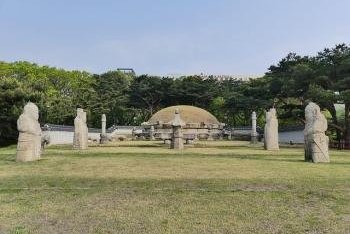
I visited this WHS in May 2017. Out of the 40 Royal Joseon Tombs spread out in 18 locations I visited the 3 tombs in the Seollung and Jeongneung cluster (closed on Mondays), which are conveniently close to the Seollung subway station (Line 2, Exit 10).
Although being at the heart of Seoul's business district, the buffer zone is a major green zone in Seoul and the old pine trees, ginko trees and cherry trees manage to hide away the surrounding skyscrapers throughout the different trails. I visited early on a quiet morning and most of the walkways were covered with pink and white cherry blossoms. I managed to spot quite a lot of different bird species while walking from one tomb to the other, the largest of which was a male pheasant.
First I visited the double mound royal tombs of King Seongjong (the 9th Joseon monarch; photo) and Queen Jeonghyeon and later on I visited the royal tomb of King Jungjong (the 11th Joseon monarch). Each tomb had 12 faced retaining stones surrounding the burial mound with a corresponding Oriental zodiac animal. Each burial mound had a 12 angled stone railing around it and upon looking closer (mostly with my zoom lens) I could notice that each stone face around the mound had intricately carved decorations.
Each tomb has something different but the main layout components of the Royal Joseon Tombs are the following: a tomb keeper's house which is used to prepare for ancestral memorial rites; a …
Keep reading 0 comments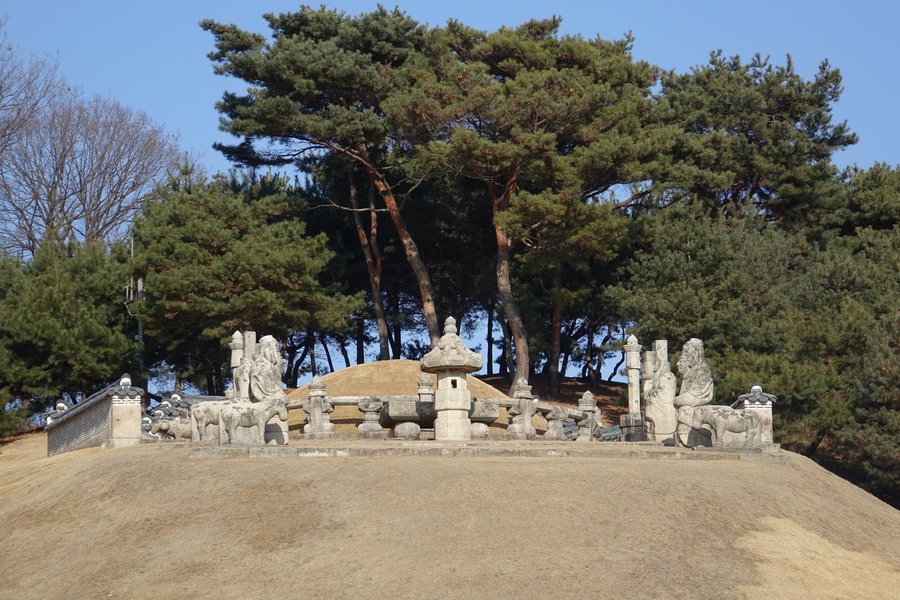
With the Royal Tombs of the Joseon Dynasty, I've finished South Korea’s batch of 12 entries on the current World Heritage List. Like many others – 6 to be precise – it lies well within the range of the Seoul Hotspot. The Joseon Tombs comprise 18 different locations, of which I chose the Donggureung Cluster to visit - “the largest and most attractive” according to Lonely Planet ánd our own South Korea expert Kyle Magnuson.
Donggureung lies in Guri, a city typical of the Seoul metropolitan area with its many numbered grey high-rise apartment blocks. The bus driver alerted me where I had to get off the bus, but I had seen it already myself, as there are big signs in Korean and English pointing to this royal cemetery. Despite the urban setting, this is a peaceful location in a forested area. There were a few other visitors when I arrived on a Friday morning, only a couple of the ubiquitous Korean pensioners and even a small group of birders. Entrance costs a nominal 1,000 Won (ca. 0.80 EUR).
Donggureung literally means "East Nine Royal Tombs”: there are 9 tombs that hold the remains of 17 Joseon kings and queens. Each of the nine has a separate setting in the forest, and paths link them. The paved paths behind the entrance gate to each tomb follow the same principle as those at the Jongmyo Shrine: the main path is for the spirits (not to be walked on by mere mortals), …
Keep reading 0 comments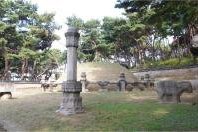
Royal tombs of the Joseon dynasty are a group of 40 tombs located on 18 different sites. They were built between 1408 and 1966 to honor Joseon ancestors' memories. They are organized on the same basis, with gates and buildings at the entrance and tombs set on the top of little hills called tumulis. On the top of these tumulis are also set up different statues representing people (soldiers, religious) and animals (sheep, cow, horses).
Some of these sites are located in Seoul and can be easily visited, taking the subway to the stop Seollung on line 2 (green) for example to see three of the tombs.
It's very interesting to visit these complexes to approach Korean culture and traditions. They are a great stone in the wall of Korean culture.
Keep reading 0 comments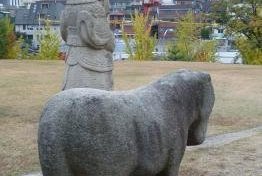
I didn’t really do this site justice; my experience was limited to one group of tombs at Seollung in the south of Seoul. These are by far the most accessible being just a short walk from the Metro station with the same name.
It was an enjoyable park to wander around for a little while and you were able to climb up and get a close up view of two of the three tombs within the site. I was surprised to see how large the statues guarding the burial mounds were, and I must admit to being quite impressed. The park now also contains a small museum with information about the tombs which are spread out across Seoul and its environs. A slight frustration came from not being able to get a closer look at King Jungjong’s tomb, from the base of the mound there isn’t really a huge amount you can see. It seems that this is a bit of a frustration at many of the tombs, and I am sure there are legitimate reasons for it but it does make the visiting experience a little limited.
If I had been in Seoul for a little longer then I am pretty sure I would have visited more of these sites, but the draw of the city’s other delights kept me busy.
[Site 4: Experience 4]
Keep reading 0 comments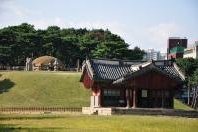
During my conference trip to Seoul and Gyeongju, South Korea, I had managed to visit Royal Tombs of the Joseon Dynasty, one of the most complete dynastic tombs in Asia, which located around the city and nearby provinces. From all tombs, I decided to visit two clusters, Seonjeongneung, better known as Seolleung in Southern Seoul, and another at Taereung in Northeastern Seoul. The reasons why I chose these two sites because of both has museum and interpretive center for tourists as well as easy connection with subway.
The tombs are located inside the beautiful forest parks, the surroundings are well kept with fantastic green lawn; however from my experience the tombs are hard to appreciate, as the sites are off-limited, few chance to see the details of stone decoration, but the museum and interpretive center can help with computer graphic show how to construct the tombs, and most important, the royal funeral ceremony as well as full size replica of stone decorations.
In my opinion, the Joseon Tombs cannot be considered as a unique site, compared with Silla Tombs in Gyeongju, the latter are more interesting with treasure discovered and tumuli construction technique. Also, most of the ancient tombs in East Asia, noble or normal people, are constructed under Fengshui doctrine. In ICOMOS report, I was surprised that ICOMOS and Korea use Chinese Imperial Tombs for comparative study as Emperor (huangdi) and King (Wang or Taewang) is totally different in tomb size and status. To be fair, …
Keep reading 0 comments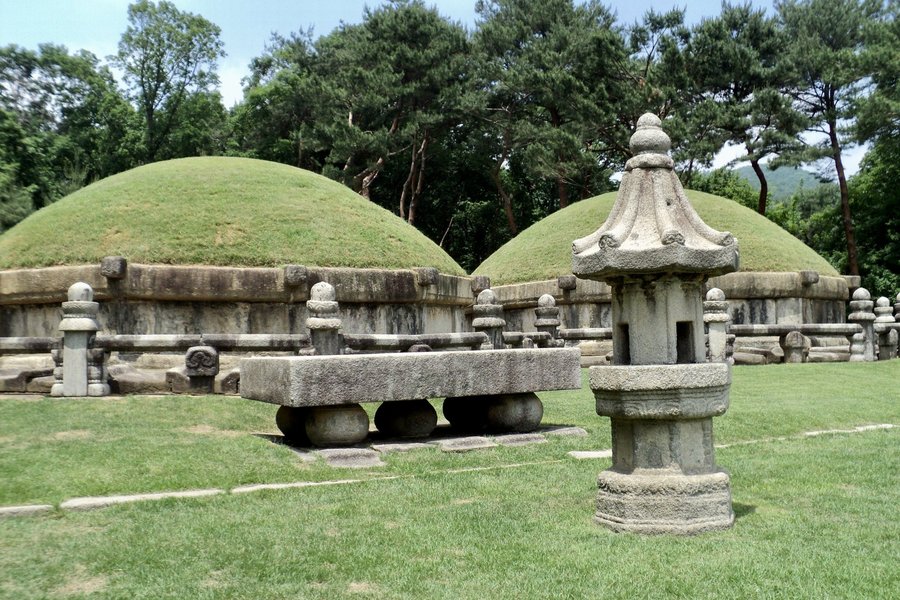
I have visited nearly all clusters of this serial world heritage site. Additionally, my first visit was in 2008 (before inscription) and I've visited many additional tomb clusters since. Pre-inscription there was generally less restrictions for visitors, in fact I remember walking right up to the tumuli amongst the stone animals and standing face to face with the tomb guardians. While this was not possible at all locations I visited at the time, it seemed generally 'allowed' that you could get closer (though obviously a certain respect was expected from visitors around the burial area). Despite how access has changed regarding the burial area, I still enjoy visiting each tomb cluster.
For me, the Tomb Guardians (Muninseok) have long been a highlight to photograph. Korea has other memorable human statues with the dol hareubang on Jeju Island, but the Muninseok of the Joseon Tombs stand out as special with their own appeal and charm.
What will you see and what should you take note of as you visit a Joseon Royal Tomb? A bonus memento is the entrance ticket that is specific to the tomb you are visiting.
Entrance Area - Typically a pleasant natural landscape, you will see a small stream and the tomb keeper's house. Near a few of these houses are historic, protected trees, sometimes centuries old.
Ceremonial Area - This is where the worship road leads to the T-shaped shrine. As you approach the shrine, you should be able to see the tumuli above and a …
Keep reading 0 comments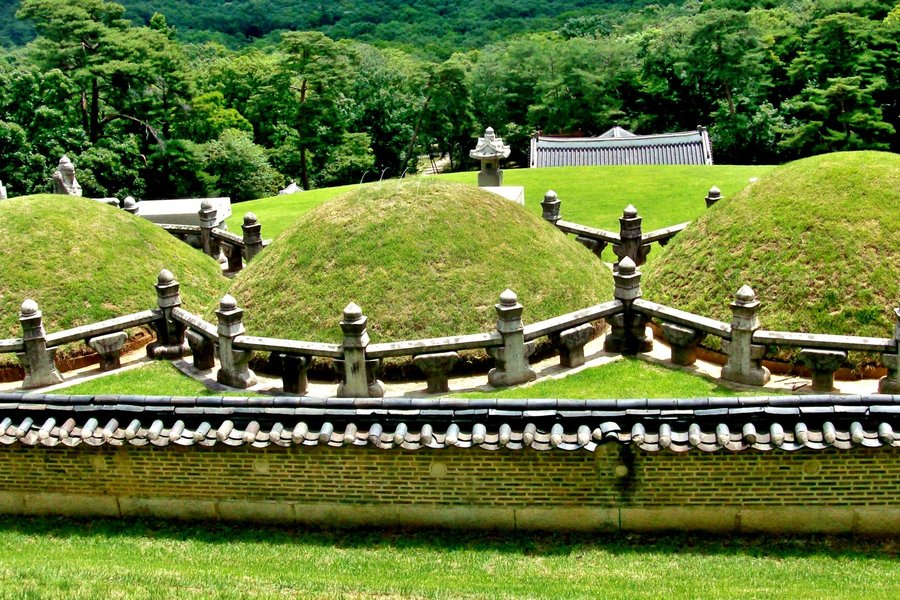
During my 5-day trip to Korea, I was able to visit 3 of the Joseon tombs.
The first was Jeongneung (in Seoul, close to Sungshin Women's University subway station). I was a little upset because the park does not allow access to the tomb itself; I wanted to see the stone statues closer but there was a fence surrounding the elevated mound. Though I have to agree that this park is set in a quiet forested area away from the city noise.
The second one I visited was Seolleung (also in Seoul) and fortunately, the park management allows visitors to get closer to the tomb. The walk in the forest is a very pleasant experience.
The last was Yungneung/Geolleung in Hwaseong City, Gyonggi-do province. My Korean friend and I decided to see this place as we had extra time after visiting Hwaseong Fortress in Suwon.
All in all, the trip to these royal tombs is a wonderful experience. There are 40 inscribed on the list; 4 are found in Seoul. But I guess visiting one or two will suffice as they all look (almost) the same.
Compared to the Qing and Ming dynasty tombs in China, the Joseon tombs are smaller; but true enough, they have a special charm.
Keep reading 0 comments
I visited Sareung, the tomb of Queen Jeongsun, the queen of King Danjong, 6th monarch of Joseon. She became queen in January 1454. It's located in Namyangju, which is in Gyeonggi-province just east of Seoul. From Guri or Donong station (on the Jungang Line) you take the bus that says Sareung(or a taxi if you prefer) for a short distance to the tomb area.
There is a botanical garden/nursery at the entrance, where they are growing wildflowers, pine trees, and even some fruit. The people that take care of the nursery give you tea and allow you to take some wildflowers with you if you choose (for tea). They gave us tea to drink, as we walked through the pine forest to the tomb. They had an outdoor photography exhibit set up in the forested area featuring various photographs of wildflowers. After a short walk under the fragrant pines, you come to a clearing where the tomb sits about two-thirds up the mountain. It's a beautiful area and the tomb is guarded by various animals (stone sculptures).
Keep reading 0 comments
I am delighted to be the first person to review this lovely site. This is a fully deserved new addition to Korea's list.
I visited the Dongguerung site last weekend. It is a peaceful and charming place that seems to be relatively free of the tour bus hordes at the moment. The tombs can easily be reached with a subway to Cheongnyangni (line 1), then exit 5 and bus 202 (that heads away from Seoul, not the one towards!). It's about 30 minutes.
The tombs are set in a beautiful woodland park, and all seem to be aligned to different points of the compass. All the tombs are set atop large mounds. You are able to walk to the top of three of them without supervision. We were able to get up a 4th by tagging onto a guided group for a few minutes. The tombs are not grand, but are simply, elegant and charming.
A really nice 'bonus' about these sites is that the Korean Government, as a celebration of their WHS listing, has made them free to enter for period. Regualarly, the entry fee is still small ($1 or $2). Isn't that a lovely contrast with India or Egypt who would have quintipled prices for foreign tourists at the very mention of a WHS?
Keep reading 0 comments
